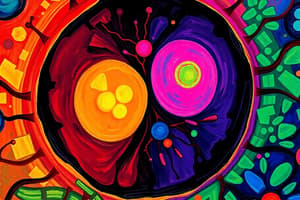Podcast
Questions and Answers
What is the primary role of mitochondria in cells?
What is the primary role of mitochondria in cells?
- Producing red blood cells
- Generating ATP for energy (correct)
- Synthesizing DNA
- Facilitating photosynthesis
Which process is associated with mitochondria's generation of chemical energy?
Which process is associated with mitochondria's generation of chemical energy?
- Photosynthesis
- Anaerobic respiration
- Aerobic respiration (correct)
- Glycolysis
What do cristae within the mitochondria provide?
What do cristae within the mitochondria provide?
- Contain the ribosomes
- More surface area for electron transport chains (correct)
- Storage space for ATP
- Facilitate DNA synthesis
In which part of the mitochondrion does chemiosmosis occur?
In which part of the mitochondrion does chemiosmosis occur?
What percentage of proteins required for normal mitochondrial functioning are encoded by their own DNA?
What percentage of proteins required for normal mitochondrial functioning are encoded by their own DNA?
Which organelle has been described to consist of two membranes enclosing a matrix space with cristae?
Which organelle has been described to consist of two membranes enclosing a matrix space with cristae?
Flashcards are hidden until you start studying
Study Notes
Mitochondria are often called the powerhouses of cells because they generate most of the cell's supply of ATP (adenosine triphosphate), which is used as an energy source by the rest of the cell. They are found within almost all human cells except red blood cells, and their primary role is creating chemical energy through oxidizing food molecules. This process is known as aerobic respiration, also referred to as cellular respiration when it occurs within mitochondria.
The basic form of a mitochondrion has been described since the earliest days of biological microscopy; it consists of two membranes enclosing a matrix space, with cristae forming inner folds of the inner membrane. These structures allow more surface area for electron transport chains, which facilitate proton pumping across the outer membrane, generating the electrochemical gradient needed for ATP synthesis via chemiosmosis in the mitochondrial matrix.
Mitochondria contain DNA and ribosomes, indicating that proteins are synthesized within them, although only approximately one third of the proteins required for their normal functioning are encoded by their own DNA. Most of these proteins have multiple copies, while several others are present in thousands per organelle due to their essential roles.
In summary, mitochondria play a crucial role in converting nutrients into energy, maintaining the pH balance of the cell, signaling pathways related to programmed cell death, and participating in apoptosis (programmed cell suicide)—all vital functions that contribute to proper cellular homeostasis.
Studying That Suits You
Use AI to generate personalized quizzes and flashcards to suit your learning preferences.




